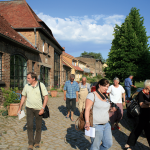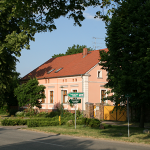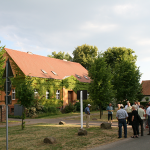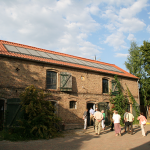Rohrlack, Brandenburg, Germany
The village of Rohrlack lies 85 km west of Berlin close to the motorway and has 172 inhabitants The village belongs to the municipality of Temnitztal and until the Second World War lived around and from an estate. During the GDR era it was disbanded, some of the farming buildings were demolished and some converted.
After the re-unification in 1989 several lucky circumstances came together in Rohrlack. The village community saw the change in times as a chance and two families from Berlin with a lot of know-how played a cautious part in the village. The forum for this constructive exchange became the Rohrlack circle; a monthly meeting of all village inhabitants that collectively discussed projects, perspectives and problems and followed up with concrete actions. Today the small village presents itself as a dynamic community which based on a holistic approach has created a future on a large scale.
Standing out above all is the „ Living and Working Committee of Rohrlack“ for about 40 handicapped people which is integrated into several locations throughout the village with living quarters, workshops, garden centre and meals. It is conceived as a permanent, anthroposophic oriented living place and is a noticeable part of village life. The guardians live together in a „House Warden Principle“ with the handicapped and the community in individual houses in the village. The facility, that has been growing since 1992, is a branch of the “Work Community Berlin-Brandenburg”.
A dynamic, environmentally aware, local economy geared towards sustainability has developed around these units A stud farm with boarding house and a village pub offer a solid basic infrastructure for locals and tourists, an eco-baker and a shop with bio-products (mostly for customers from Berlin) with an affiliated nursery work in close cooperation with the “Living Committee Rohrlack”. This economic micro cosmos that reflects a successful cooperation of the village and the city 85 km away has created numerous new jobs, and to boot in a region with an unemployment rate of 17 percent and at the same time has proven to be social enrichment.
The special strengths of Rohrlack are the distinctive club enthusiasm of its inhabitants and the high level of citizen participation. The small village has amongst other things a fire brigade with its own building, a church that was renovated with a lot of citizen commitment with numerous cultural offerings and not last the “Rohrlack Circle” as a paradigm of institutionalised participation.
The awareness for alternative energy and conservation of resources is very much present in the small companies and the population. Concrete projects are being planned and implemented. New buildings and renovations have been integrated into the whole area whose overall picture is still influenced by the former estate and its remaining farm buildings. To be able to replant the village and its surroundings the village community supports its own nursery where it cultivates trees. More than 900 trees have been planted.
The village consciously seeks to network with the surrounding villages which is documented for example in the cultural club Temnitztal and the association Vigaro.
Rohrlack impresses with a cautious development in conjunction with village inhabitants, newcomers and outsiders. A sensitive and ideal integration of handicapped people in the village arose from this exemplary cooperation which in addition is clearly interested in networking. All of this is possible through the great commitment of the population to its interests and by doing so demonstrate and realise an impressive sustainability.
Evaluated: 2008




